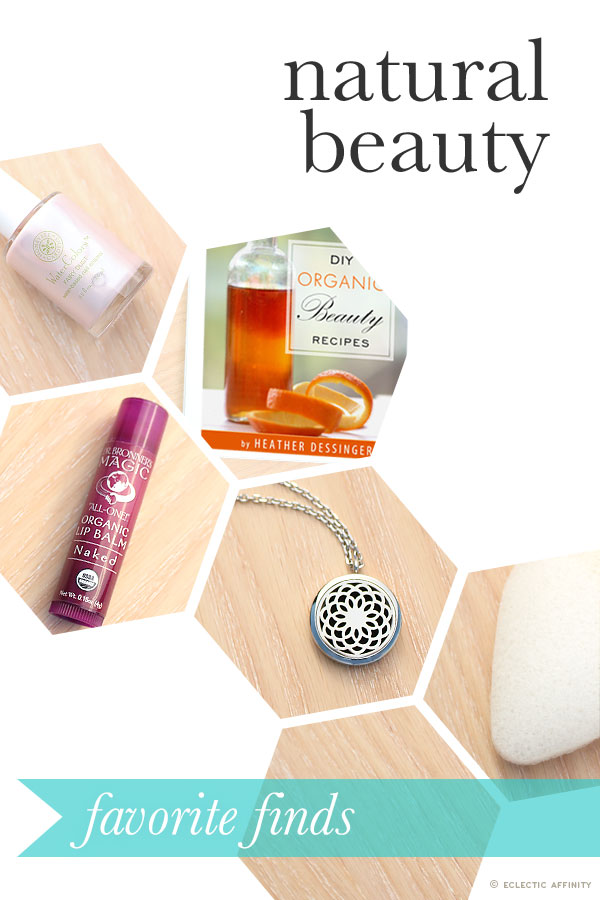Some links are affiliate links. If you purchase anything after clicking, it’s a no-cost way to support my blog. Read my policies and disclosure here.
I’m not a real stickler about regular, scheduled hair cuts, I’ve never colored my hair, and I can’t recall ever carrying “just in case” touch-up makeup in my purse save for maybe just before a job interview. My beauty “regimen” is fairly low-key, but if I find something worthwhile and natural, I like to pass it on. Here are a few recent favorites.
Several years back when I started really reading product labels, I got rid of a lot of things—including all my nail polish. It wasn’t much of a sacrifice because doing the artsy stuff I do with my hands, manicures don’t stand much chance, so they’ve never been much of a priority. Plus, I hate the smell of nail polish and remover. I did miss sporting toenail polish with sandals, but I’d kind of forgotten about nail polish as even being an option for a crunchy gal until I read this post by Wellness Mama where she breaks down several different natural nail polish brands. I got this one by Honeybee Gardens in “Fairy Dust.” It doesn’t smell, and while some say that rubbing alcohol works to remove the polish, I prefer just soaking my feet in water and scratching it off. It is water-based after all. (I’m also still curious about trying this kind that peels off.) For easier removal, I like to make sure my nails aren’t overly dry to start with by using a light lotion or oil (like argan oil) a little while before applying polish and then buffing with a chamois nail buffer (looks like this) that I confess I only have because it used to be my mom’s. (Thanks, Mom!)
If you check the ingredients and ratings for common beauty and skin care brands and products on the Environmental Working Group’s Skin Deep Cosmetics Database, you’ll notice that many don’t score so well. (Since it would be quite the feat for all products in existence to be in the database, if the product you’re looking for isn’t there you can also check each ingredient by name if the whole product isn’t listed.) Here’s where in real life I lose people on this topic because “bad ingredients” sounds so vague and unquantifiable. It makes it sound like “oh, well, it’s just this one thing.” Except, anymore those tiny concessions are in most things. So it’s that “one thing” added to one hundred more things in just that same day. The EWG cites that the average woman daily uses 12 products (containing a total of 168 different ingredients) and the average man daily uses 6 products (containing 85 different ingredients). That’s a big deal on its own, then consider that’s only the average person and we have no idea how these ingredients cross-react with each other let alone for longterm use. Think of your shampoo, makeup, shave gel, the hand-sanitizer you use at work, the liquid hand soap in the restaurant bathroom…it adds up more quickly than you think. Also, did you know that just because something is for sale that doesn’t mean it’s safe—or how about that companies aren’t required to list every single ingredient? For more myths and facts on cosmetic safety, click here. Reading ingredients is a start, but you might be surprised at how simple it can be to make your own products. I’ve had the DIY Organic Beauty Recipes e-book by Mommypotamus for a couple years now, and honest-to-goodness this thing is printed and bound with plastic sheet protectors in a binder. Among many other things, I’ve made my own lotion. Myself. Used a double-broiler and everything, and I have jars and jars of lotion. That I made…all by myself. Heather’s practical directions make it really simple while taking the intimidation factor out, which I really appreciate because the idea of making lotion was more than a little intimidating to me. I also appreciate that each ingredient in her book is well researched and each recipe is well tested. One thing I still need and want to make but haven’t yet (solely for consistently forgetting to buy beeswax) is lip balm. I’ve conquered lotion, so I really do need to try lip balm because how great does “Orange Vanilla Dream Lip Balm” sound? Plus, she has alternate recipe configurations within each balm recipe to create various textures of lip balm since personal preferences can vary. That brings me to my next find.
The one pseudo-makeup thing I will carry with me is lip balm. Even if you make most of your beauty and skin care stuff, it’s always helpful to have a few go-to brands with understandable ingredients that can quickly be thrown into a purse (read: “diaper bag”) if you’re in a pinch and need something when you’ve run out. I like this lip balm because it’s smooth and moisturizing, not waxy like other brands I’ve tried in the past.
I prefer natural scents over perfume, so I really liked the idea of having an essential oil diffuser necklace. However, because I feel one does best doing what one knows how to do well, I like to stay within my own jewelry-making repertoire despite also being a jewelry maker myself. When it came to essential oil diffuser jewelry, however, I met a hang-up. First, just in general I’m a bit of a stickler on the kind of metal I prefer to wear because not all jewelry is made of quality (and dare I say “safe”) materials. Check out this post for more on that. Second, if heat and/or sweat can increase absorption of materials touching the skin, I wondered what essential oils could do with less than optimal metals. This is in theory only, of course, but again, I’m a stickler when it comes to jewelry. Let me explain. Essential oils are less of an oil as they are highly concentrated plant essences. Consider that it can take around 75 lemons, 27 square feet of lavender plants, or 1 whole pound of raw peppermint to create one 15ml bottle of their respective essential oils. Undiluted essential oils (and even diluted citrus ones) are potent enough that it’s commonly advised to keep them away from plastics because they may be able to leach the chemicals from the actual plastic itself into whatever is stored inside. Knowing all that, I wanted to find a diffuser necklace made by someone who’d taken all that into consideration, someone who’d done the research, someone who’d put together components that I felt comfortable wearing. Frankly, I thought I’d be filing that search alongside the Loch Ness monster and Atlantis, but alas there was an answer to my diffuser jewelry quest. Made from 100% hypoallergenic 316L surgical grade stainless steel with a sturdy chain and patent-pending, interchangeable, eco-friendly diffuser pads, I’ve been pleased to wear mine with various scents. (I think lemon + grapefruit together has been my favorite so far.) I love the geometric simplicity of the Lotus Flower design, but I’ve also been eyeing the smaller, gold-tone Old World Cross design. If you’re looking for a diffuser necklace or bracelet, I’ve been really impressed by Diffusing Mamas!
I first heard of the My Konjac Sponge via Mama Natural. Curious, I ordered one. I was surprised at first when it came that it felt like the kind of white styrofoam you find in the crafts department—that is, until it softens when exposed to water. After that point, the texture reminds me of how chia seeds turn soft and gelatinous when soaked. Washing with it feels refreshing and seems to make my face feel a little softer. Like starting with any new facial cleansing method, I did notice a short (maybe a day or two) adjustment period where I saw some tiny breakout action around my nose, which makes sense considering these sponges are said to mildly exfoliate and potentially draw out blackheads. For removing makeup, I still prefer the Oil Cleansing Method or a microfiber cloth (I like and use the microfiber body cloths, not the makeup cloths). I can’t say for certain whether or not I’m seeing fewer blackheads simply because that’s kind of subjective. I mean, how often does a person count their blackheads? I definitely like it enough to continue using it, and I’m interested in trying one of the other varieties like the clay or charcoal ones as well. As a side note, I do wonder that a small bathroom isn’t the best location to hang this to dry. Being able to fully dry between uses is a good idea for the same reasons it’s a good idea for towels. Some keep their sponge in the fridge (which is an interesting and probably refreshing option) or periodically boil the sponge in water for a few minutes. However you maintain it, know that you will need to replace it after a couple months or so of use. Since it’s made using a sustainable plant root though, you can throw it in your compost pile!
Do you have any natural beauty favorites that you really enjoy?






